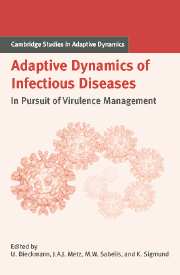Book contents
- Frontmatter
- Contents
- Contributing Authors
- List of Boxes
- Notational Standards
- 1 Introduction
- A Setting the Stage
- B Host Population Structure
- C Within-Host Interactions
- D Pathogen–Host Coevolution
- E Multilevel Selection
- F Vaccines and Drugs
- G Perspectives for Virulence Management
- Introduction to Part G
- 27 Taking Stock: Relating Theory to Experiment
- 28 Virulence Management in Humans
- 29 Virulence Management in Wildlife Populations
- 30 Virulence Management in Veterinary Epidemiology
- 31 Virulence Management in Plant–Pathogen Interactions
- 32 Virulence Management in Biocontrol Agents
- 33 Epilogue
- References
- Index
- International Institute for Applied Systems Analysis
30 - Virulence Management in Veterinary Epidemiology
Published online by Cambridge University Press: 15 January 2010
- Frontmatter
- Contents
- Contributing Authors
- List of Boxes
- Notational Standards
- 1 Introduction
- A Setting the Stage
- B Host Population Structure
- C Within-Host Interactions
- D Pathogen–Host Coevolution
- E Multilevel Selection
- F Vaccines and Drugs
- G Perspectives for Virulence Management
- Introduction to Part G
- 27 Taking Stock: Relating Theory to Experiment
- 28 Virulence Management in Humans
- 29 Virulence Management in Wildlife Populations
- 30 Virulence Management in Veterinary Epidemiology
- 31 Virulence Management in Plant–Pathogen Interactions
- 32 Virulence Management in Biocontrol Agents
- 33 Epilogue
- References
- Index
- International Institute for Applied Systems Analysis
Summary
Introduction
In northern Europe, there is currently a tendency toward more “natural” livestock production. The proponents of this view believe that animals should be kept in herds and able to move about freely, that the (regular) administration of drugs should be reduced, and that it is wrong to destroy whole flocks to eradicate disease. In addition, there remain requirements for economically viable livestock production that yields safe food for human consumption. These aims can be reached in two ways: by complete eradication of certain agents (e.g., by mass vaccination), or by avoidance of disease caused by other agents. In writing about infectious diseases, the terminology often causes confusion. We adhere to the following definitions: agent – the microorganism that can sometimes cause disease (because disease does not always occur, and because the effect may even be favorable, the term pathogen is avoided); infection – colonization of the host (i.e., some replication of the agent in the host); and disease – clinical symptoms of the host caused by the agent. Eradication is preferable when the disease causes severe economic damage (e.g., foot-and-mouth disease, classic swine fever) or when there are serious consequences for human health (e.g., bovine tuberculosis, bovine spongiform encephalopathy).
When there is a high rate of reintroduction (e.g., from other animal species), the monetary costs to restore the infection-free status again and again can be higher than the losses caused by the disease.
- Type
- Chapter
- Information
- Adaptive Dynamics of Infectious DiseasesIn Pursuit of Virulence Management, pp. 425 - 435Publisher: Cambridge University PressPrint publication year: 2002
- 2
- Cited by



